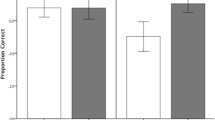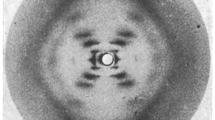ABSTRACT
The purpose of the current study was to examine the nature of the relationship between learners’ distrust of scientific models that represent unseen entities and phenomena, their spatial ability, and the vividness of their mental images. The sample consisted of 302 tenth grade students in the Sultanate of Oman. Three measures were used for this study: the Epistemologies about the Credibility of Scientific Models instrument, the Water Level Task (WLT), and the Vividness of Microscopic Mental Images. It was found that students’ distrust was greater for theoretical and abstract models such as the electron clouds, photons, magnetic lines of force, DNA, electron transfer, atomic orbits, and alpha rays. The findings also show that there was a statistically significant negative correlation between students’ distrust of scientific models and their spatial ability, as indicated by their performance on the WLT. There was a positive relationship between the distrust of scientific models and the vividness of mental images and a weak negative relationship between spatial ability and the vividness of mental images. Based on the findings, it might be plausible to conclude that as the abstraction level for scientific models increases, such as for theoretical models which lack defined structure and known details, imaginative learners’ difficulty to construct colorful and detailed mental images for natural entities and phenomena increases. It would also be recommended that learners with vivid mental images should be provided with and directed to use more spatial techniques such as computerized visualization tools and mental manipulation of 3D objects.
Similar content being viewed by others
References
Ackermann, E. K. (1991). From de-contextualized to situated knowledge: Revisiting Piaget’s water-level experiment. In I. Harel & S. Papert (Eds.), Constructionism (pp. 367–379). Norwood, NJ: Ablex Publishing.
Al-Balushi, S. M. (2009). Factors influencing pre-service science teachers’ imagination at the microscopic level in chemistry. International Journal of Science and Mathematics Education, 7(6), 1089–1110. doi:10.1007/s10763-009-9155-1.
Al-Balushi, S. M. (2011). Students’ evaluation of the credibility of scientific models that represent natural entities and phenomena. International Journal of Science and Mathematics Education, 9(3), 571–601. doi:10.1007/s10763-010-9209-4.
Black, A. A. (2005). Spatial ability and earth science conceptual understanding. Journal of Geosciences Education, 53(4), 402–414.
Bowen, C. W. (1994). Think-aloud methods in chemistry education: Understanding student thinking. Journal of Chemical Education, 71(3), 184–190.
Bucat, B. & Mocerino, M. (2009). Learning at the sub-micro level: Structural representations. In J. Gilbert & D. F. Treagust (Eds.), Multiple representations in chemical education (pp. 11–30). Dordrecht, the Netherlands: Springer.
Carter, C. S., Larussa, M. A. & Bodner, G. M. (1987). A study of two measures of spatial ability as predictors of success in different levels of general chemistry. Journal of Research in Science Teaching, 24(7), 645–657.
Clement, J. (2008). Creative model construction in scientists and students: The role of imagery, analogy, and mental simulation. Dordrecht, the Netherlands: Springer.
Clements, D. H. (1998). Geometric and spatial thinking in young children. ERIC document reproduction service, no. ED 436232.
Coll, R. & Treagust, D. F. (2001). Learners’ mental models of chemical bonding. Research in Science Education, 31, 357–382.
Cook, M., Wiebe, E. N. & Carter, G. (2008). The influence of prior knowledge on viewing and interpreting graphics with macroscopic and molecular representations. Science Education, 92, 848–867.
Crawford, B. A. & Cullin, M. J. (2004). Supporting prospective teachers’ conceptions of modelling in science. International Journal of Science Education, 26(11), 1379–1401.
Czolpinski, A. & Babul, A. (2005). The art of physics: Visualizing the universe, seeing the unseen. Pi in the Sky, 9, 4–8.
Davidowitz, B. & Chittleborough, G. (2009). Linking the macroscopic and sub-microscopic levels: Diagrams. In J. Gilbert & D. F. Treagust (Eds.), Multiple representation in chemical education (pp. 169–191). Dordrecht, the Netherlands: Springer.
Diezmann, C. M. & Watters, J. J. (2000). Identifying and supporting spatial intelligence in young children. Contemporary Issues in Early Childhood, 1(3), 299–313.
Gericke, N. M. & Hagberg, M. (2007). Definition of historical models of gene function and their relation to students’ understanding of genetics. Science Education, 16, 849–881.
Gilbert, S. W. (1991). Model building and a definition of science. Journal of Research in Science Teaching, 28, 73–79.
Gilbert, J. & Reiner, M. (2000). Thought experiments in science education: Potential and current realisation. International Journal of Science Education, 22(3), 265–283.
Gobert, J. D. & Buckley, B. C. (2000). Introduction to model-based teaching and learning in science education. International Journal of Science Education, 22(9), 891–894.
Gooding, D. C. (2004a). Cognition, construction and culture: Visual theories in the sciences. Journal of Cognition and Culture, 4(3), 551–593.
Gooding, D. C. (2004b). Envisioning explanations—The art in science. Interdisciplinary Science Reviews, 29(3), 279–294.
Grosslight, L., Unger, C., Jay, E. & Smith, C. L. (1991). Understanding models and their use in science: Conception of middle and high school students and experts. Journal of Research in Science Teaching, 28(9), 799–822.
Halloun, I. A. (2007). Mediated modeling in science education. Science Education, 16, 653–697.
Halpern, D. F. (1986). Sex differences in cognitive abilities. Hillsdale, NJ: Lawrence Erlbaum.
Halpern, D. F., Benbow, C. P., Geary, D. C., Gur, R. C., Hyde, J. S. & Gernsbacher, M. A. (2007). The science of sex differences in science and mathematics. Psychological Science in the Public Interest, 8(1), 1–51.
Harrison, A. G. & Treagust, D. F. (1996). Secondary students’ mental models of atoms and molecules: Implications for teaching chemistry. Science Education, 80(5), 509–534.
Harrison, A. G. & Treagust, D. F. (2000). A typology of school science models. International Journal of Science Education, 22(9), 1011–1026.
Hegarty, M. (2004). Mechanical reasoning by mental simulation. Trends in Cognitive Sciences, 8(6), 280–285.
Kali, Y. & Orion, N. (1996). Spatial abilities of high-school students in the perception of geologic structures. Journal of Research in Science Teaching, 33(4), 369–391.
Kozhevnikov, M., Hegarty, M. & Mayer, R. (1999). Students’ use of imagery in solving qualitative problem in kinematics. ERIC document reproduction service, no. ED 433239.
Kozhevnikov, M., Hegarty, M. & Mayer, R. (2002). Revising the visualize–verbalizer dimension: Evidence for two types of visualizers. Cognition and Instruction, 20(1), 47–77.
Kozhevnikov, M., Kosslyn, S. M. & Shepard, R. N. (2005). Spatial versus object visualizers: A new characterization of visual cognitive style. Memory & Cognition, 33, 710–726.
Kozhevnikov, M., Motes, M. A. & Hegarty, M. (2007). Spatial visualization in physics problem solving. Cognitive Science, 31, 549–579.
Kozma, R. & Russell, J. (2005). Students becoming chemists: Developing representational competence. In J. K. Gilbert (Ed.), Visualization in science education (pp. 121–145). Dordrecht, the Netherlands: Springer.
Li, C. (2000). Instruction effect and developmental levels: A study on water-level task with Chinese children ages 9–17. Contemporary Education Psychology, 25, 488–498.
Li, C. (2001). Why do Chinese students perform well on spatial tasks? Chinese teachers’ perspective. ERIC document reproduction service no. ED 459414.
Linn, M. C. & Petersen, A. C. (1986). A meta-analysis of gender differences in spatial ability: Implications for mathematics and science achievement. In J. S. Hyde & M. C. Linn (Eds.), The psychology of gender: Advances through meta-analysis (pp. 67–101). Baltimore, MD: Johns Hopkins University Press.
Liu, C. & Treagust, D. F. (2005). An instrument for assessing students’ mental state and learning environment in science education. International Journal of Science and Mathematics Education, 3, 625–637.
Lohman, D. F. (1993). Spatial ability and G. Paper presented at the First Spearman Seminar, University of Plymouth, UK, July.
Lord, T. (1985). Enhancing the visuo-spatial aptitude of students. Journal of Research in Science Teaching, 22(5), 395–405.
Lord, T. (1990). Enhancing learning in the life sciences through spatial perception. Innovative Higher Education, 15(1), 5–16.
Lord, T. & Nicely, G. (1997). Does spatial aptitude influence science–math subject preferences of children? Journal of Elementary Science Education, 9(2), 67–81.
Marks, D. (1972). Visual imagery differences in the recall of pictures. British Journal of Psychology, 64, 17–24.
Mathewson, J. H. (1999). Visual–spatial thinking: An aspect of science overlooked by educators. Science Education, 83, 33–54.
Ministry of National Economy (2004, January). Distribution of population by region. Census 2003 Bulletin, pp. 8–28.
Naveh, D. (1985). Holistic education in action: An exploration of guided imagery in a middle grade science class and its impact on students. Retrieved 7 October 2008 from ProQuest database: http://wwwlib.umi.com/dissertations/search.
Ozmen, H., Demircioglu, G. & Coll, R. (2009). A comparative study of the effects of a concept mapping enhanced laboratory experience on Turkish high school students’ understanding of acid–base chemistry. International Journal of Science and Mathematics Education, 7(1), 1–24.
Pascual-Leone, J. & Morra, S. (1991). Horizontality of water level: A neo-Piagetian developmental review. In I. Reese (Ed.), Advances in child development and behavior (Vol. 23, pp. 231–276). New York, NY: Academic.
Pribyl, J. R. & Bodner, G. M. (1987). Spatial ability and its role in organic chemistry: A study of four organic courses. Journal of Research in Science Teaching, 24, 229–240.
Pulos, S. (1997). Explicit knowledge of gravity and the water-level task. Learning and Individual Differences, 9(3), 233–247.
Reiner, M. (2008). The nature and development of visualization: A review of what is known. In J. Gilbert, M. Reiner & M. Nakhleh (Eds.), Visualization: Theory and practice in science education (pp. 25–27). New York, NY: Springer.
Reiner, M. & Gilbert, J. (2000). Epistemological resources for thought experimentation in science teaching. International Journal of Science Education, 22(5), 489–506.
Rodgers, G. E. (1994). Introduction of coordination, solid state, and descriptive inorganic chemistry. New York, NY: McGraw-Hill.
Ryan, A. G. & Aikenhead, G. S. (1992). Students’ preconceptions about the epistemology of science. Science Education, 76(6), 559–580.
Schwarz, C. V. (1998). Developing students’ understanding of scientific modeling. Unpublished doctoral dissertation, University of California at Berkeley, California, USA.
Seng, A. S. & Tan, L. C. (2002, April). Cultural and gender differences in spatial ability of young children. Paper presented at the Annual Meeting of the Association for Childhood Education, San Diego.
Shepard, R. (1988). The imagination of the scientist. In K. Egan & D. Nadaner (Eds.), Imagination and education (pp. 153–185). New York, NY: Teachers College Press.
Solomon, J., Scott, L. & Duveen, J. (1996). Large-scale exploration of pupils’ understanding of the nature of science. Science Education, 80(5), 493–508.
Stieff, M. & Raje, S. (2010). Expert algorithmic and imagistic problem solving strategies in advanced chemistry. Spatial Cognition and Computation, 10, 53–81.
Treagust, D. F., Chittleborough, G. D. & Mamiala, T. L. (2004). Students’ understanding of the descriptive and predictive nature of teaching models in organic chemistry. Research in Science Education, 34, 1–20.
Vasa, R. & Liben, L. (1996). The water-level task: An intriguing puzzle. Current Directions in Psychological Science, 5, 171–177.
Velez, M. C., Silver, D. & Tremaine, M. (2005). Understanding visualization through spatial ability differences. Paper presented at the IEEE Visualization, Minneapolis, October.
Vos, W. & Verdonk, A. H. (1996). The particulate nature of matter in science education and in science. Journal of Research in Science Teaching, 33(6), 657–664.
Wang, C.-Y. & Barrow, L. (2010). Characteristics and levels of sophistication: An analysis of chemistry students’ ability to think with mental models. Research in Science Education, 41(4), 561–586. doi:10.1007/s11165-11010-19180-11167.
Ward, T. & Scott, J. (1987). Analytic and modes of learning family resemblance concepts. Memory & Cognition, 15, 42–54.
Wu, H., Krajcik, J. S. & Soloway, E. (2001). Promoting conceptual understanding of chemical representations: Students’ use of a visualization tool in the classroom. Journal of Research in Science Teaching, 38(7), 821–842.
Wu, H. & Shah, P. (2004). Exploring visuospatial thinking in chemistry learning. Science Education, 88, 465–492.
Yang, E., Andre, T., Greenbowe, T. J. & Tibell, L. (2003). Spatial ability and the impact of visualization/animation on learning electrochemistry. International Journal of Science Education, 25(3), 329–349.
Author information
Authors and Affiliations
Corresponding author
Rights and permissions
About this article
Cite this article
Al-Balushi, S.M. THE RELATIONSHIP BETWEEN LEARNERS’ DISTRUST OF SCIENTIFIC MODELS, THEIR SPATIAL ABILITY, AND THE VIVIDNESS OF THEIR MENTAL IMAGES. Int J of Sci and Math Educ 11, 707–732 (2013). https://doi.org/10.1007/s10763-012-9360-1
Received:
Accepted:
Published:
Issue Date:
DOI: https://doi.org/10.1007/s10763-012-9360-1




